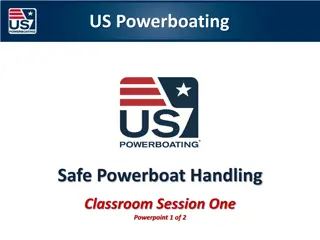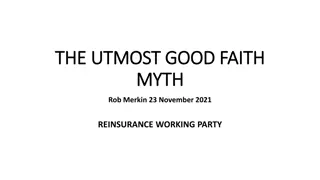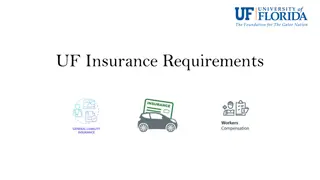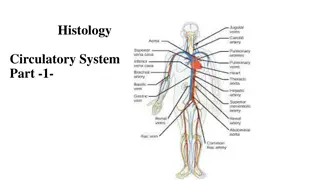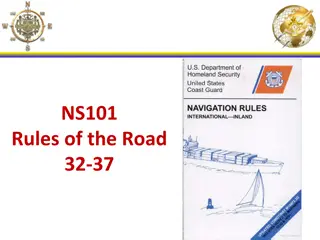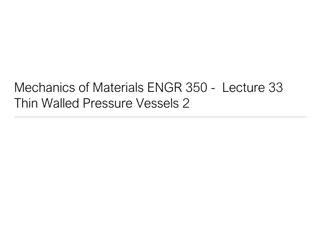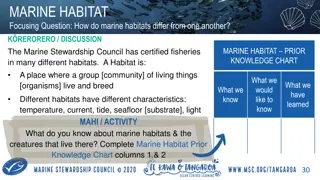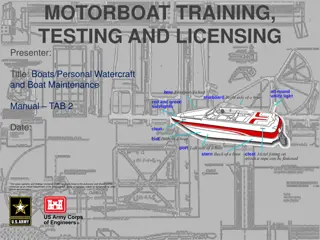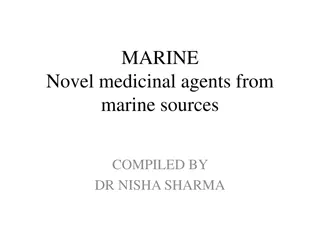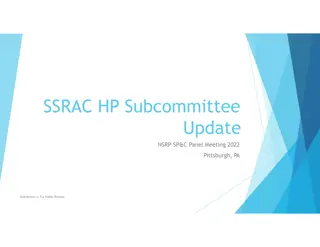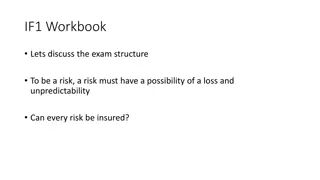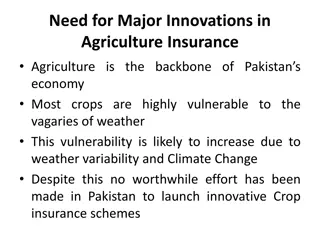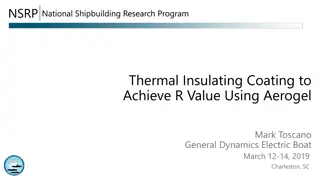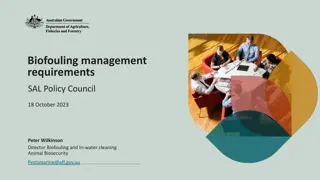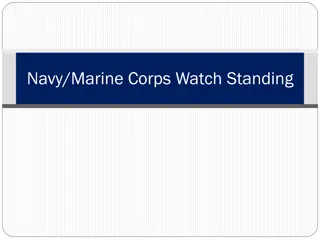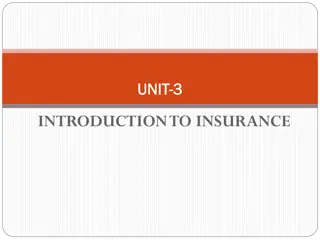Understanding Marine Hull Insurance for Vessels
Marine Hull Insurance encompasses the protection of various vessels, such as ocean-going ships, fishing vessels, and more, covering damages, liabilities, and construction risks. The policy, issued for 12 months, includes Charterers Liability, Ship Repairers Liability, and indemnity for vessels under construction. Ship-owners, mortgagees, and other parties involved can obtain Hull insurance, with various vessel types like liners, tramps, and tankers falling under its coverage.
Download Presentation

Please find below an Image/Link to download the presentation.
The content on the website is provided AS IS for your information and personal use only. It may not be sold, licensed, or shared on other websites without obtaining consent from the author. Download presentation by click this link. If you encounter any issues during the download, it is possible that the publisher has removed the file from their server.
E N D
Presentation Transcript
INTRODUCTION Hull Insurance is related with the insurance of Hull and Machinery of ocean going vessels and other various types of vessels like barges, trawlers, sailing vessels, fishing vessels, dredgers etc., which are termed as Sundry Vessels. The policy also covers other subsidiary interests of the insured such as Freight and Disbursement. The Hull insurance also provides indemnity against damage to Ship under construction which is covered under Builder s Risk policy.
MARINE HULL INSURANCE The Charterers Liability risks, Ship Repairer s liability, Oil and Energy risks alongwith its connected construction risk fall under Hull Insurance. Hull refers to the shell of the ship but in insurance terminology Hull denotes the whole ship, vessel and craft including its machinery. The Ship is commonly described as steel hulled, self propelled ocean going vessel.
MARINE HULL INSURANCE Craft is described as small vessels which navigate in lakes, rivers, harbours and along the coast. Major Hulls include ocean going vessels carrying cargo/passengers etc. All ingredients applicable to a commercial contract are also applicable to Hull insurance. The policy is generally issued for 12 Months and the premium is allowed to be received in instalments. Marine Hull contracts are Modified Indemnity contracts.
MARINE HULL INSURANCE The Hull insurance also provides indemnity against damage to Ship under construction which is covered under Builder s Risk policy. Marine Hull policies are generally valued policies. The value of the ship and its machinery so declared by the insured at the inception of cover becomes binding on both the insured and the insurer and is conclusive unless gross overvaluation with ulterior motive on the part of the insured is established. Unvalued policy is issued to cover ship-owner s freight. Sec 18(2) provides In insurance on freight, whether paid in advance or otherwise, the insurable value is the gross amount of the freight at the risk of the assured, plus the charges of insurance.
MARINE HULL INSURANCE WHO CAN TAKE HULL INSURANCE The Ship-owner who owns the vessel can obtain Hull insurance. The other parties like Mortgagees like Bank and Financial institution, Charterers, Bailees have also insurable interest. The Hull policy cannot be issued to the Time or voyage charterer. The policy, however, may be issued to the bareboat charterer or demise charterer.
MARINE HULL INSURANCE TYPES OF VESSELS Liners: Liners maintain an advertised route according to a fixed schedule. Liners are built to carry passengers or cargo. Tramps: These vessels carry any type of cargo for which they are normally chartered. Tramps do not maintain any advertised routes under a fixed schedule. Tankers: Tankers are specially built and equipped for carrying liquid cargo in bulk. The vessel is divided into longitudinal oil-tight divisions each of which is used as a separate compartment. These tankers are designed as Very Large Crude Carrier (VLCC) and Ultra Large Crude Carrier (ULCC) depending upon its carrying capacity.
MARINE HULL INSURANCE TYPES OF VESSELS Gas Carriers: Gas carriers are designed to carry Liquefied Petroleum gas(LPG) which is used for fuel and fertilisers and liquid natural gas(LNG) used as industrial and domestic fuel. It has temperature and pressure control system to monitor any change arising out of atmospheric differences in course of voyage. Fishing Vessels: These vessels are mostly wooden built operated in Indian coastal waters for fishing purposes. These vessels may be mechanized or non mechanized. Fishing Trawlers: Trawlers are steel built mechanized vessels used for catching fish in the deep sea. It is designed to go 300 or more nautical miles into the sea. Sailing Vessels: Sailing vessels or country craft are wooden or steel built, mechanized or non mechanized which are used to carry cargo between Indian Ports and also between other countries like Pakistan, East Africa, Sri Lanka, Middle East countries etc.
MARINE HULL HINSURANCE TYPES OF VESSELS Coastal Tonnage: Coasters are generally smaller in size and are engaged in the carriage of Bulk Cargo. Coastal vessels enter and leave port more frequently and operate in congested waters. Dry Bulk Carrier: These vessels are specially designed in the size range of a few thousand GRT used for coasters to over 70,000 GRT for ocean going tonnage. The bulk carriers are used to carry ores, grain, coal, sugar etc. While underwriting the risk, the underwriters should obtain information about the nature of cargo carried, route involved for plying, classification, registration, casualty details, if any etc. Container Vessel: These vessels are used to carry containerized cargo. vessels are fully dependent on sophisticated shore and discharge facilities. Carrying capacity of container is determined according to the following terms: TEUs (20 foot equivalent units i.e. up to 20 tons capacity). FEUs ( 40 foot equivalent units i.e. 40 tons capacity). Container
MARINE HULL INSURANCE TYPES OF VESSELS Lighter Aboard Ship: lighters are floated out to the ship and are lifted into specially designed holds by ship s own lifting gantry. LASH ship is designed to carry pre-stowed lighters. The loaded Roll on-Roll off( RO-RO) vessel : A RO RO vessel carries a whole range of wheeled vehicles without involving any cranes. When cargo is carried by lorries/ trucks from one place to another place through sea voyage, Ro Ro vessel is engaged to carry the vehicles in the vessel and to release the same after arrival at the destination.
MARINE HULL INSURANCE EMPLOYMENT OF VESSEL Liner Trade Employment of ships by the owners involved in liner trade. These ships carry general bulk cargo. The ships are employed by their owners involved in a liner trade. The owners maintain full control over the ship and appoint crew and incur all expenses necessary for owning and running it. Voyage Charter A ship may be chartered to carry cargo from a specified port to another specified port. In the particular case, the ship-owner pays for all the costs except loading and discharging costs of the cargo which are paid by the charterer. The charterer also pays the freight for the voyage. However, the ship-owner keeps control over the ship and is obliged to complete the voyage as per Charter party agreement.
MARINE HULL INSURANCE TIME CHARTER A ship can be engaged under time Charter for a specific period of time. The charterer pays the hire money and the ship plies according to the choice of the charterer for trading purpose. DEMISE CHARTER A ship can be chartered as bare boat or demise charter. Under this agreement, the charterer supplies the Crew and operates the ship. The charter is usually fixed for a long period. Sometimes, there may be bareboat charter cum sale agreement where the charterer becomes the owner of the Chartered ship.
MARINE HULL INSURANCE SHIP S TONNAGE The GRT of the ship is the cubic capacity of all enclosed spaces permanently closed in. NRT is GRT less the capacity of spaces occupied by such items as machinery, equipment and crew. DWT is the weight of removable items carried by a ship.
MARINE HULL INSURANCE RISKS COVERED UNDER HULL POLICY Hull Policy 1.10.1983 covers loss of or damage to cargo caused by Perils of the seas rivers lakes or other navigable waters Fire, explosion Violent theft by persons from outside the vessel Jettison Piracy Breakdown of or accident to nuclear installations or reactors Contact with aircraft or similar objects, or objects falling therefrom, land conveyance, dock or harbor equipment or installation Earthquake volcanic eruption or lightning Accidents in loading discharging or shifting of cargo or fuel Bursting of boilers breakage of shafts or any latent defect in the machinery or hull Negligence of master officers crew or pilots
MARINE HULL INSURANCE RISKS COVERED UNDER HULL POLICY Negligence of repairers or charterers provided such repairers or charterers are not an Assured hereunder Barratry of Master officers or Crew provided such loss or damage has not resulted from want of due diligence by the Assured, Owners or Managers Master officers Crew or Pilots not to be considered Owners within the meaning of this Clause




